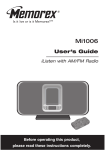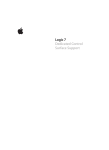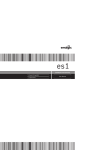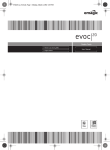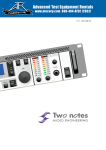Download Maya 4.5 for OS X
Transcript
REVIEWS Reviews you can trust: Macworld rates only final shipping products, not prototypes. What we review is what you can actually buy. LOGIC PLATINUM 5.3 Veteran Program Brings Professional Music Production to a Mac OS X World BY DAVID LEISHMAN Almost two years to the day after Apple released the beta of its Unix-based operating system, Emagic (now owned by Apple) introduced Logic Platinum 5.3 for Mac OS X, the first professional digital-audio–production application to work in the new OS. Of Logic’s chief competitors—Digidesign’s Pro Tools, MOTU’s Digital Performer, and Steinberg’s Cubase—only Cubase was OS X native at press time. The other two products should be OS X native by the fourth quarter of 2002. The OS X–native Logic (available as an update on Emagic’s Web site) is great news for the Mac and gives Logic users temporary bragging rights, but it’s still gearing up for prime time. Emagic’s subsequent release of an OS 9 version ensures that longtime Mac users—and those switching from Windows—will have a rich, full-featured production environment to work with as they migrate to OS X. (Although Emagic hasn’t made any announcements regarding further OS 9 development, it seems inevitable that the company will concentrate on moving to the new platform.) And you can move files easily between the two versions, which are similar except for some OS X– specific issues. More Power, New Gear Logic Platinum 5.3, the fifth update to a massive 5.0 upgrade released in February 2002, adds minor tweaks and bug fixes to a host of new features. A key to its power is the addition of AltiVecbased DSP optimization, which | 32 | MACWORLD | January 2003 | means that you can work with more simultaneous tracks and plug-ins on PowerPC G4 machines than on other Macs. Logic’s Audio Engine also has enables you to output mastering-quality recordings: two personal favorites are DeEsser, used to reduce harsh S sounds in vocals, and Multipressor, a highly customizable multiband compressor. And you can now monitor plug-ins on a track you’re recording without affecting the sound that’s captured— from a musician’s standpoint, you get to hear the sound you Your Main Axe Logic’s Track Mixer mirrors a studio mixing console to let you record, as well as choose input sources, signal paths, and effects plug-ins. been significantly beefed up and can now handle 128 audio channels, with 64 auxiliary channels for 128 stereo tracks; 15 inserts per track and bus; and 64 buses—enough signal-routing control to satisfy even a seasoned studio professional. New timesaving features include the ability to control real-time track-based automation within Logic’s main Arrange window—the old process of moving between windows was tedious, especially as tracks stacked up—and the addition of multiple undos and redos, which can be lifesavers. Logic’s new series of plug-ins want, and from an editor’s or producer’s standpoint, you get a clean track for subsequent processing. This is invaluable. One more new feature merits mention: real-time sample-rate conversion, which lets you move high-resolution audio files between your desktop and your laptop and get excellent sound on either. Making Tracks While Logic Platinum 5.3 makes it easy to record your tracks, it’s a complicated program with enough power and control to allow you to express even your most complex sonic visions. You’ll begin to appreciate what the phrase tough learning curve means as you work with the menus that appear in the editing windows. Be prepared to spend some quality time with the manual and the help section to get the most from your investment. Logic’s installation process follows the standard double-clickand-choose-your-drive-or-partition method, but it’s followed by a bout with Emagic’s latest copy-protection system, which at best is a double-edged sword. It requires going back and forth via e-mail with Emagic for your XSKey Authorization number, and it requires that you to use a small USB key, or dongle, for storing the access code. Since your authorization resides in the dongle, not in the computer, you can install Logic on any USBenabled Mac and activate it by inserting the dongle. This is fine, but if you lose it, you’ll be not only out of a dongle but also out the $349 it costs to replace it. After this hassle, though, it’s a pleasure to finally reach Logic’s home base, the straightforward Arrange window, where you can record audio and MIDI tracks quickly. (You can also import files—including Sound Designer II, AIFF and WAV, and standard MIDI files—that were recorded in another program.) If you’ve used a music sequencer, or even a VCR, the interface will be reassuringly familiar. You can also record tracks in the Track Mixer window, where you can add any of Logic’s nearly 60 on-board plug-ins, either during the take or in subsequent editing, until you find the right sound. And as your track load increases, you can group tracks that you want to affect in the same way (with the same amount of reverb, for example) and apply the plug-in there; this will help reduce the load on your CPU as tracks mount up. | www.macworld.com | 32 Music-production application Logic Platinum 5.3 33 3-D–graphics package Maya Complete 4.5 35 CRT-calibration system Sony Artisan Color Reference System 37 Compression utility StuffIt Deluxe 7 38 All-in-one backup system ABSplus 39 Speech-recognition software iListen 1.5 40 Bibliography program EndNote 6 41 Sound-output device M-Audio Sonica OUTSTANDING: mmmmm X Time? The release of Logic Platinum 5.3 is indeed great news, and Logic users should download it if they’ve moved to OS X. Emagic recommends that you install the program on the boot volume, but we ran it successfully across drives and partitions. The application didn’t crash once during our testing, and it certainly looks more attractive in Aqua. We got snappier response in OS X 10.2.1 than in 10.1.5, but track counts for both ran just slightly behind OS 9’s. There’s support for Apple’s built-in Sound Input and Output and most of Emagic’s hardware, and many developers have released OS X–based drivers for their gear. (Our M-Audio Delta 1010LT seamlessly routed MIDI and audio data.) While the OS X version is fine for moderate usage, you’ll likely have to boot into OS 9 for final production. Logic for OS X is an unfinished product, missing a lot of OS and interapplication communication. And as of press time, there was no OS X–specific manual—a real pain. After an hour of frustration with Jaguar’s new Audio MIDI Setup utility, a quick call to Emagic’s excellent tech support revealed that it isn’t supported yet. (It should be noted that Apple doesn’t include a help section for the utility, either.) Unsupported formats and protocols in version 5.3 include Rewire import and export, Rex import and export, OMF (Open Media Framework), OpenTL, and Apple’s own Audio Units technology for using plug-ins and soft synths in OS X, but the real kicker is the lack of VST support. Many people who create digital music have more money invested in VST tools than in a music sequencer, and they’re watching the market for VST plug-ins closely. Emagic has promised to release a free library that will enable VST | www.macworld.com | 41 6.1-megapixel SLR camera Nikon D100 42 Network-troubleshooting and -management program LANsurveyor 7.0 44 Removable-media storage Zip 750MB FireWire External Drive VERY GOOD: mmmm GOOD: mmm developers to quickly and easily port their products to Apple’s format. This would be great because Audio Units promises systemwide plug and play for products from different manufacturers, which means greater performance capability for you. (Emagic released Logic Platinum 5.4 exclusively for OS X 10.2 at press time. We were able to check this version and confirm that it worked with Audio Units and Rex file import. We also found a bug; Logic 5.4 would hang while recognizing the MIDI hardware each time we relaunched the program. Emagic’s tech support suggested that this was due to a problem with Jaguar’s Core MIDI technology, and they told us to reinstall our Delta drivers. We did, but to no avail.) Macworld’s Buying Advice Logic Platinum 5.3 offers a comprehensive set of tools for digital-audio production, and it’s very stable. If you currently use Logic, version 5.3 is a musthave upgrade, and the program is a worthy, if complex, choice for those new to music sequencing. But if you use a competing product, you may want to wait for the verdict on its OS X– native version before you decide to switch to Logic. RATING: mmmm PROS: Approachable but professional-level program; stable; great included plug-ins. CONS: Copy-protection dongle is a liability; no OS X–specific documentation; no OS X support for system technologies and third-party formats. PRICE: $949; upgrade from version 4 or 5, $149; upgrade from version 1, 2, or 3, $399 OS COMPATIBILITY: Mac OS 9, Mac OS X COMPANY: Emagic, 530/477-1051, www.emagicusa.com 44 Electronic encyclopedia Britannica 2003 Ultimate Reference Suite 45 Compact DV camera Panasonic PV-VM202 45 Reviews in Brief A New Kind of Science Explorer, Consistency 1.0 FLAWED: mm 36 This Month in Digital Cameras Canon PowerShot G3, Fuji FinePix F401, Kodak EasyShare LS443, Minolta Dimage 7Hi, Nikon Coolpix 4300, Nikon Coolpix 5700, Sony Cyber-shot DSC-F717 UNACCEPTABLE: m MAYA COMPLETE 4.5 3-D System’s Second Release for Mac Gets Real, Offers Subdivision Surface Modeling BY SEAN WAGSTAFF The combination of tightly integrated and completely scriptable modeling, character animation, physics-based dynamic and particle simulation, and remarkably flexible rendering in Alias|Wavefront’s Maya is unmatched by most other 3-D–effects packages, including NewTek’s LightWave 3D and Electric Image’s Universe. So when Alias|Wavefront shipped Maya for Mac OS X 3.5 late last year (Reviews, January 2002), we were delighted to see it running on the Mac for the first time, despite concerns about the program’s performance. When we reviewed Maya again in June, most of its bugs had been worked out and its price had dropped significantly, but the Mac version still hadn’t caught up to its Windows and Linux counterparts. But with Maya Complete 4.5, the wait for a no-compromises version of Maya is finally over. Version 4.5 addresses nearly every criticism we had of version 3.5. What’s more, it’s a smooth, stable performer in OS X 10.2 (it doesn’t run in OS 9). Maya 4.5 borrowed its most significant feature addition, subdivision-surface modeling, from Maya Unlimited ($6,999, for Windows or Unix only). And for animators and effects artists, the Mac version offers vital new features of its own, in addition to a much better interface and performance improvements that make it ready for prime time—literally. Maya’s New Skin The headline feature in version 4.5 is subdivision-surface modeling, a tool that has long been standard in LightWave 3D. Subdivision surfaces let 3-D artists build lifelike characters, as well as smoothly blended organic creatures and surfaces, using simple polygonal modeling. They often produce better results in less time than NURBS (nonuniform rational B-splines), which are also used for modeling organic surfaces. Combined with Maya’s topof-the-line character-animation tools (including a new Jiggle Deformer for realistic flab), this feature allows artists who use Macs to readily create characters with the same type of detail and lifelike movement seen in animated films such as DreamWorks’ Shrek or television programs such as ABC’s Dinotopia. Character modelers will particularly appreciate a new Cut Faces tool that makes polygonal modeling—and by extension, subdivision modeling—much easier to do. Furthermore, this release introduces simple, onecontinues RATING: mmmmh PROS: Timesaving subdivisionsurface modeling; incredibly flexible dynamic simulations; lifelike character animation; improved performance and interface; cross-platform compatibility; low price. CONS: No rendering queue or network rendering; speed and quality of rendering needs improvement. PRICE: $1,999; upgrade from 3.5 node-locked license, $699; upgrade from 3.5 floating license, $839 OS COMPATIBILITY: Mac OS X COMPANY: Alias|Wavefront, 877/405-6645, www.aliaswavefront.com | January 2003 | MACWORLD | 33 | REVIEWS step conversion of subdivision models to NURBS patches, so even studios that need NURBS in their pipelines have a powerful, timesaving alternative to patch modeling. Maya’s renderer lacks some advanced effects, such as global illumination and caustics, and its speed is sometimes criticized when compared with LightWave 3D and Universe. However, the vast majority of users will be quite pleased with Maya’s out-of-the-box rendering capabilities, which include a rich selection of lighting types, as well as an impressive tool set for working with and managing shades and textures. There is at least one major problem that has not been addressed, though: Maya’s socalled Batch Renderer, which can neither queue more than one animation on a single machine nor manage rendering over multiple networked computers. These functions are essential in environments where renderings are measured in many minutes or hours per frame, and where productivity calls for offloading the process from the artist’s workstation as much as possible. But much to the relief of artists who have an eye for nuances, a Mac-compatible version of Mental Image’s Mental Ray plug-in rendering engine is in the works. We anticipate that it will address the majority of Maya’s rendering issues. Furthermore, Alias|Wavefront will offer this $3,995 plug-in—nearly double the price of Maya alone— for free to all version 4.5 users. (According to Mental Image, the Mac version of Mental Ray is expected to ship this winter.) Smooth Sailing Overall, Maya is now much easier to use, thanks to a number of minor additions and interface enhancements throughout the program. For example, it offers many new snapping options, including the ability to snap objects to one another based on multiple snapping points. Also new is a set of Align tools and many added constraints in the Transformation tools, such as the ability to scale an object on two axes while locking its third axis. Also to improve ease of use, Maya now ships with a nicely designed set of ready-made Shelves (Maya’s customizable tool palettes), and its Marking Menus (pop-up menus that give you access to commands) offer many new options and features. The Mac version of Maya has reached parity with Maya’s Windows, Irix, and Linux versions; this will be of major importance in production envi- Dynamic Dynamite Maya’s Dynamics engine is among the best. In this OpenGLshaded preview, shapes attached to the rear wheels emit dust clouds; the size and transparency of the sphere-shaped dust particles are driven by their randomized life spans. ronments where Macs and PCs share studio space. We had no trouble either sharing files or working and rendering interchangeably on Windows syst e m s a n d M a c s ; h o w e v e r, negotiating the differences in keyboard layouts for standard key commands was a minor annoyance. More problematic is the unavailability of a vast library of plug-ins for Mac users, including Alias|Wavefront’s Real-Time Author and Right Hemisphere’s Deep Paint, as well as dozens written by small, independent developers. Command Performance Double Feature Maya Complete 4.5 supports dual processors and readily crosses platforms, but subdivision-surface modeling is the star of this release: by building a simple polygonal model (right), you can easily create smooth, detailed characters (left). | 34 | MACWORLD | January 2003 | Of all the usability enhancements in Maya 4.5, the most significant are its gains in performance. Although Maya now supports dual processors for rendering and other computationintensive functions, users will notice mainly that the program is simply faster and more fluid than it was, even on single-processor Macs. Actions such as painting 3-D textures onto surfaces with Maya’s delightful Paint Effects brushes are now fast and fluid. We enjoyed running Maya on an 800MHz Titanium PowerBook G4, whose ATI Radeon Mobility 7500 chip set was able to keep up with Maya. Part of the reason for the change in speed and flow is the fact that we were running OS X 10.2; the other part is Maya’s greatly reduced dependence on specialized graphics cards with hardware overlays. To give credit where it’s due, we should say that we tested version 4.5 with the newest OpenGL cards—including ATI’s Radeon 8500 and the Nvidia-based GeForce4 Titanium, from Apple—on a dual800MHz Power Mac G4. Both cards offered big performance gains compared with older cards and finally laid to rest our criticism about OpenGL on the Mac. We highly recommend adding a top-end OpenGL card to any Maya purchase. Macworld’s Buying Advice It’s true that Maya’s rendering features and performance need some work, and it will be some time before Mac users have access to the variety of plug-ins available to users on other platforms. But despite these relatively minor gripes, Maya Complete 4.5 is a must-have program for graphic artists or animators who are serious about 3-D animation. At a great price, the program adds many improvements—including cross-platform compatib i l i t y, s u b d i v i s i o n s u r f a c e modeling, and vastly improved performance—to an already impressive feature set. | www.macworld.com | SONY ARTISAN COLOR REFERENCE SYSTEM New CRT Provides Accurate, One-Button Calibration in a Sleek, 21st-Century Package BY BRUCE FRASER For Apple, the CRT may be dead, but for those of us who need accurate, stable, predictable color, the CRT not only is alive and well but also continues to improve. The Sony Artisan Color Reference System is a case in point. This $1,729 21-inch monitor-and-calibrator bundle provides rock-solid contrast and color without the viewing-angle problems and lack of uniformity that plague LCD monitors. And with a maximum resolution of 2,048 by 1,536 ppi, it also displays more pixels than current LCDs. The Artisan runs in both OS 9.2 and OS X 10.1, and it offers one-button calibration for people who rely on a monitor when making critical decisions about tone and color—such as digital photographers, designers, and prepress technicians. The entire package is beautifully designed—from the neutral gray monitor case and its padded hood, to the software’s look-andfeel, to the sensor’s exquisite industrial design. Developed by Dr. Karl Lang, father of the Radius Pressview, the system acts like a Pressview manufactured start to finish by Sony with the benefit of five years of hindsight, rather than one put together by Radius. Start with a Monitor The heart of the Artisan system is the Sony GDM-C520K monitor, a state-of-the-art 21-inch flatscreen Trinitron with a low, 0.24mm aperture-grille pitch that supports horizontal scan frequencies from 30kHz to 130kHz and vertical refresh rates from 48Hz to 170Hz—all of which adds up to sharp, flicker-free performance even at high resolutions. It has all the advanced controls you’d expect from a high-end monitor, including | www.macworld.com | individual red, green, and blue gain and bias controls, and separate convergence controls for top, center, and bottom, conveniently accessible through a joysticklike control on the front gain and bias to the desired color and luminance of white and black, instead of simply adjusting levels in the video card’s lookup table. Some third-party calibrators let you do this manually, but with the Artisan it’s automatic. Moreover, it’s extremely accurate. After calibrating the monitor, we could see a difference between each level from 0 through 10, and as we cycled through the levels, the grays remained dead-on neutral. Before we encountered the Artisan, the only monitors that Sleek and Simple To calibrate the monitor, just choose a target color space, click on the Calibrate button, and follow directions to attach the sensor to the screen. bezel. But what makes the Artisan system much more than just another monitor is the Artisan sensor and calibration software. Marry It to a Sensor The Artisan sensor is a very sensitive colorimeter whose filters are matched to the phosphors used in the GDM-C520K monitor. Therefore, it provides very accurate data to base the monitor profile on—it won’t work particularly well on monitors with different phosphor sets, but on the GDM-C520K, it’s more accurate than any generalpurpose instrument. The Artisan sensor also avoids the major weakness of most affordable third-party monitor calibrators: their inability to accurately measure black. The Artisan software communicates directly with both the sensor and the monitor through USB connections. The software uses the feedback from the sensor to adjust the monitor’s RGB had passed this extreme-torture test with flying colors sported a Barco logo. The upshot is that you get reliable calibration with a predictable contrast range, which is essential for making fine judgments about tone and color. Control It with Software The Artisan Color Reference System is also easy to use. Setup is a breeze—the only part that’s even slightly tricky is that one end of the monitor cable has both a D-Sub 15 and a USB connector, and you have to make sure to plug that end into both the video card and one of the USB ports on the Mac. (Unlike many competing CRTs, such as the LaCie electron22blue III and NECMitsubishi’s 22-inch SpectraView models, the Artisan monitor doesn’t have a built-in USB hub.) The software’s interface has a modern look-and-feel that matches the rest of the product. If you use one of the default settings, calibration and profiling really are a one-button process— but if you think defaults are for the timid, you’ll find that you have complete control over defining new aim points for color temperature, black and white luminance, and gamma. A unique Artisan feature is the ability to save calibration data for different monitor resolutions: once you’ve calibrated the monitor at two different resolutions, you can switch freely between them without having to recalibrate. A full calibration takes about ten minutes and is good for 30 days; after that, the software forces you to recalibrate. While some competing systems allow you to set a warning for a userselectable calibration period, Sony takes the same approach as Barco. But the software also offers a quick Update Calibration Data feature that revalidates the calibration in about three minutes—if you run this once a week or so, you can avoid the lengthier routine. In dual-monitor setups, you can calibrate the Artisan only when it’s the main monitor, but once it’s calibrated, you can move the menu bar to the second monitor if you wish. Macworld’s Buying Advice If you need accurate, predictable color from your display, day in and day out, and you’re willing to pay a premium price for it, the Sony Artisan Color Reference System will give you your money’s worth. It’s more expensive than comparable solutions from competitors such as NECMitsubishi and LaCie, but it provides shadow performance matched only by the considerably more expensive Barco Reference Calibrator V. RATING: mmmmh PROS: Reliable; one-button, accurate calibration and profiling; great industrial design. CONS: Takes up two USB ports and provides none; must be your main monitor during calibration. PRICE: $1,729 OS COMPATIBILITY: Mac OS 9, Mac OS X COMPANY: Sony, 877/865-7669, www.sony.com | January 2003 | MACWORLD | 35 | REVIEWS ENDNOTE 6 Citation-Making Software Adds Mac OS X Support and New Productivity Features BY FRANKLIN N. TESSLER For more than a decade, ISI ResearchSoft’s EndNote has made life easier for authors who need to include citations and bibliographies in their work. Last year, we chided ISI for releasing EndNote 5 without support for OS X or Microsoft Word X (Reviews, January 2002). EndNote 6 corrects this misstep by providing OS X and Word X compatibility—in fact, now it’s for OS X only. EndNote 6 also has several new features that can make academic writers even more productive than before. More Than Text We ran EndNote 6 in OS X 10.1.5 without a hitch (an OS X 10.2–compatible version should be shipping by the time you read this). Like its predecessors, EndNote 6 stores text references in a specialized database called an EndNote 6 library. As you write, you copy selected references from the library into your document; EndNote formats the in- text citations and bibliography to suit the publication for which you’ve indicated you’re writing, as we discuss later in this review. With version 6, you can export all the references embedded in a formatted Word document into a new or existing EndNote library. Although the exported references don’t contain notes, abstracts, images, or captions, this is an easy way to share bibliographies with your colleagues without sending them your online EndNote library. The program goes a step further by also letting you create references that contain pictures, artwork, and other nontextual data and then insert them into your manuscript as figures. With the Insert Image command, you can add any JPEG, TIFF, GIF, BMP, or PNG file to a reference (see “The Best Image”). A similar command, Insert Object, links an EndNote reference to any type of file—it’s handy for cataloging PDF documents and other files that Insert Image doesn’t support. The Best Image The EndNote 6 library displays a thumbnail view of graphics linked to text references in EndNote’s new Image field. | 40 | MACWORLD | January 2003 | To insert a figure into a Word document, you use a new tool called Find Figures to search the library for references that contain images and other graphics. EndNote 6 copies the contents of the linked file into your manuscript, along with the file’s caption, and generates a figure citation at your chosen insertion point. If you later move or delete a figure, EndNote 6 can renumber the figures and rearrange them and their captions accordingly. The only limitation is EndNote’s inability to handle multiple-part figures: for example, one consisting of figure 2a and figure 2b. It’s unfortunate that EndNote doesn’t provide a tool for managing tables. If you’re writing for a journal that requires independent numbering schemes for tables and figures, as many do, you’ll have to number the tables manually. Still, EndNote’s ability to insert and keep track of figures is sure to be a big time-saver. Easy Formatting Academic writers face enough of a challenge in making sure their information is valid—they don’t want to worry about proper formatting as well. EndNote 6 helps here by providing Wordcompatible templates for 145 publications, from the Journal of the American Chemical Society to the Journal of Virology. You can fill in the template manually, or you can use EndNote’s Manuscript wizard, which asks you to supply the basic information most publishers require, such as a title, authors, and keywords. EndNote creates a formatted document from your data, complete with margins, headings, and markers for all the required sections. Special placeholders tell EndNote where to place the bibliography and figure list in the final manuscript. The program even chooses a bibliographic style that matches the publication you’ve selected. In our tests, EndNote did an excellent job of selecting styles and putting all the elements in their proper place. If the journal you need isn’t on EndNote’s list, you can try to modify an existing template by opening it in Word. However, neither EndNote’s printed manual nor its online help offers any guidance on how to accomplish this. Although we managed to devise a rough template after some experimentation, we weren’t able to edit its placeholders or customize its Manuscript wizard to request specific information. New on the Menu In addition to a pleasing Aqua interface, EndNote 6 sports revamped, more logically arranged menus. For example, the commands in version 5’s Text, Terms, and Paper menus have been incorporated into the Edit menu and the new Tools menu. Alas, EndNote veterans will also note that the Scan Paper menu, which allowed you to format WordPerfect, Nisus, AppleWorks, and plain-text documents, is missing—EndNote 6 supports only Word X. (Until ISI delivers on its promise to restore the Scan Paper function in a future update, you can use EndNote 5 with these other word processors in OS 9 or in OS X’s Classic mode. EndNote 6 ships with a version 5 CD.) Macworld’s Buying Advice Despite its minor limitations, EndNote 6’s ability to import and organize text references and figures will save hours of frustrating work. Whether you use version 5 or still enter and format references by hand, EndNote 6 will be a worthwhile investment. RATING: mmmm PROS: Automatically inserts figures in manuscripts; templates simplify document formatting. CONS: Doesn’t handle tables or multipart figures; limited ability to customize manuscript templates; supports only Word X. PRICE: $300; download, $240; upgrade, $100; upgrade download, $90 OS COMPATIBILITY: Mac OS X COMPANY: ISI ResearchSoft, 800/722-1227, www.endnote.com | www.macworld.com | M-AUDIO SONICA Expand Your Mac’s Sound Horizons BY GIL KAUPP Looking to get high-quality stereo sound from your Mac? If you don’t have access to a surround-sound system but still want to increase your Mac’s sound fidelity by hooking it up to your receiver, M-Audio’s cool blue Sonica will let you do just that. Featuring a minijack stereo analog output and a 24-bit, 96kHz digital optical (SPDIF) output, the portable Sonica plugs into your Mac’s USB port and uses licensed TruSurround XT software, from SRS Labs, to simulate multichannel surround sound via just two speakers. The Hookup Getting started with the Sonica is easy, and the process is well described in the manual: you just install the driver, attach a USB cable, and select the Sonica as your sound output device—then you’re ready to experience surround-sound audio via your Mac. This ease of installation has a flip side, however: M-Audio doesn’t include the TOSLink (optical) cable you’ll need to connect the Sonica to your receiver—and at approximately $20, this cable is expensive. If your receiver doesn’t have digital inputs, you can hook up the Sonica’s analog output to your receiver using a standard 1 ⁄8-inch minijack cable. The supplied drivers worked without a glitch, and M-Audio’s tech support responded promptly to our test call. Sound Quality The sound quality is significantly better via the optical NIKON D100 Digital SLR Adds Strong Choice to Semipro Camera Market BY RICK LEPAGE In the low end of the digital single-lens reflex (SLR) camera market, one company’s absence has been conspicuous: Nikon. But now—two years after the release of Canon’s highly successful 3.1-megapixel EOS D30 and months after Canon’s 6.3megapixel follow-up, the EOS D60 ( mmmm ; Reviews, August 2002)—Nikon has entered the fray, with its $1,999 D100, an impressive 6.1-megapixel camera that aggressively goes after the market Canon is targeting. Feels Like Film The primary appeal of SLR digital cameras is that they look, feel, and act like 35mm film cameras. They have many of the advanced controls found in their film-based counterparts | www.macworld.com | and, best of all, accept off-theshelf lenses that offer much better optical performance than the lenses in point-and-shoot digital cameras. (As is the case with most digital SLR cameras, the D100 doesn’t come with a lens.) Anyone familiar with Nikon’s 35mm cameras will feel right at home with the D100; its controls are, for the most part, very similar. And it incorporates many of Nikon’s excellent features, including the 3-D Matrix metering system, a high-powered builtin flash, and support for Nikon’s high-quality Nikkor AF lenses. cable than it is through either the Sonica’s analog output or the Mac’s. The digital output is louder and cleaner, and the upper frequencies are crystal clear, while the volume level of Sonica’s analog output is low, making it difficult to enjoy simulated surround sound via your headphones. The Sonica’s digital output can carry multichannel sound such as Dolby Digital 5.1 (AC-3), Dolby Pro Logic, and DTS to your receiver for decoding, but if you want to use Apple’s DVD Player to play a DVD, you won’t get the multichannel sound you expect, since Apple’s DVD player doesn’t yet support this feature. According to M-Audio, a future update of DVD Player should fix this, since multichannel sound is the DVD standard. For now, in OS X 10.1.5, the freeware VLC (VideoLan Client, available at M-Audio’s Web site) can pass AC-3 sound to your receiver. The TruSurround XT settings in Sonica’s own Sound Accessing the D100’s comprehensive set of features can be difficult. The camera’s body has a lot of buttons and wheels that take some getting used to, and some actions—such as deleting images, using the LCD to zoom in on an image, and changing the ISO setting—require more effort to perform than they should. Once we were up-tospeed, however, we found that using many of the features became second nature. The D100 produces very high-quality images. They have a bit more contrast than the images the EOS D60 generates, and in general they are fairly soft, but neither characteristic is a mark against either camera. Both issues can be adjusted easily in Adobe Photoshop, and the softness of the D100’s images helps to keep noise levels down. Another attribute that will appeal to photographers in the field is the D100’s long battery life. We shot and viewed hundreds of pictures before needing preference panel can simulate surround sound even with just two speakers, as well as enhance dialogue and bass reproduction, but these settings won’t necessarily improve sound quality. Macworld’s Buying Advice The Sonica’s digital output greatly improves the sound quality you can get from your Mac, even in higher-end setups. If you want to expand your digital hub to include your stereo setup, the Sonica is your best bet. RATING: mmmm PROS: Solid drivers; good manual; good tech support; clear sound improvement; great design. CONS: Analog output not loud enough for headphone use; Dolby Digital (AC-3) playback available in OS X 10.1.5 only with freeware DVD player. PRICE: $89 OS COMPATIBILITY: Mac OS 9, Mac OS X COMPANY: M-Audio, 800/9696434, www.m-audio.com to recharge its lithium-ion battery. (It’s worth noting that the D60 is also an excellent camera in this regard.) Macworld’s Buying Advice Overall, the D100 is a solid, light, easy-to-use camera that offers excellent controls and long battery life, supports a range of lenses, and takes great pictures. Although we prefer the Canon EOS D60 for its more refined user interface, you really can’t go wrong with the Nikon D100—especially when you consider that it costs $200 less than the D60 and has a comparable bundle. RATING: mmmm PROS: Excellent image quality; rich feature set; long battery life. CONS: Accessing some features can be awkward. PRICE: $1,999 OS COMPATIBILITY: Mac OS 9, Mac OS X COMPANY: Nikon, 800/645-6689, www.nikonusa.com | January 2003 | MACWORLD | 41 |






